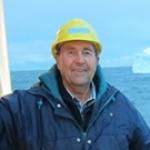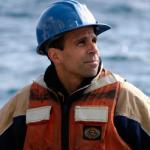Origin and Fate of Harmful Algal Blooms in the Warming Chukchi Sea
The Pacific sector of the Arctic Ocean is warming, in particular the shallow Chukchi Sea. As a result, it is anticipated that many organisms may migrate northward or become more abundant as air and ocean temperatures continue to warm. However, few pose such significant threats to human and ecosystem health as harmful algal bloom (HAB) species. Data collected over the past decade clearly indicate that multiple toxic HAB species are present in the Arctic food web at dangerous levels, and it is very likely that this problem will persist and perhaps worsen in the future. HABs occur in the Chukchi Sea and we know that the potent neurotoxins they produce can affect marine mammals, seabirds, and other resources critical to subsistence harvesters. At the same time, little is known about the present and future risk from toxic algae to humans in the Pacific Arctic region. This study will investigate the current distribution of highly toxic HAB species at high resolution over large spatial scales within the Alaskan Arctic and along its transport pathways, and will provide estimates of areas at high risk of toxicity now and in a warming future. The investigators will disseminate results via brochures, public lectures, and radio interviews in Native communities, as well as through discussions with local scientists and managers. A PolarTREC teacher from Alaska will participate in research activities and will help introduce HAB science to K-12 classrooms.
The hypothesis underlying this project is that harmful algal bloom species (HABs) in Alaskan Arctic waters are not only advected from the south through Bering Strait but are now originating locally on the Chukchi shelf due to warming temperatures, circulation dynamics, and water mass structure that influence bloom magnitude, duration, toxicity, and recurrence. This will be addressed through a joint physical-biological field and laboratory program to study the relationship between HAB species distribution/dynamics and the physical environment of the Chukchi Sea region. The distribution of HAB species on the Chukchi shelf will be mapped in relation to hydrography and circulation, including a comprehensive survey of the Alaskan Coastal Current which transports the warmest water in the Chukchi Sea. A range of molecular and physiological tools will be used to investigate the origin, connectivity, and fate of HAB populations in the region in the context of large-scale wind forcing and partitioning of water masses flowing through Bering Strait and the Chukchi Sea. Cyst and isotope profiling will establish a historical record of blooms along the major transport pathways to the western Arctic. Finally, conceptual models of the origin, transport, and fate of HABs in the Chukchi Sea region will elucidate linkages to the flow pathways, dynamics, and characteristics of the different water masses.
This project will study the relationship between harmful algal blooms and the physical environment of the Chukchi Sea. The researchers believe that these algal blooms have historically come up from the Bering Sea, but increasingly they originate locally in the Chukchi shelf due to warming temperatures, circulation dynamics, and water mass structure that influence bloom magnitude, duration, toxicity, and recurrence. Fieldwork will be conducted from the R/V Norseman II and researchers on the cruise will focus on harmful algal blooms between the northern Bering Sea and western Beaufort Sea. This fieldwork was originally scheduled for 2020 and then 2021 but was delayed due to COVID-19 restrictions. During July/August of 2022, 16 researchers and a PolarTREC teacher will embark on a 28-day cruise (Leg One) aboard the R/V Norseman II out of Nome, sampling locations comprising nine transects from the northern Bering Sea to the western Beaufort Sea. A second cruise will take place in August/September for 21 days (Leg Two), repeating the same route as Leg One, to the extent possible. Leg One will focus primarily on the Harmful Algal Blooms (HABs) and Leg Two will focus on the Biogeochemical (BGC) survey (see Appendix A). Researchers will take samples from approximately 250 stations, consisting of CTDs, water sampling, plankton tows, grab sampling, multi-cores, and gravity cores, between 62 and 73 degrees of Latitude. Additionally, three researchers will conduct work aboard the R/V Norseman II during transit between Homer and Nome before starting Leg One. PolarTREC teacher Rebecca Siegel (1918637RS) will join the field team for Leg One aboard the R/V Norseman II. During August/September of 2024, three researchers will visit the Nome/St. Lawrence Island region to communicate their recent findings and implications from the 2022 cruise, discuss potential HAB impacts to food safety and security in local communities, and learn about the knowledge and history of HABs in the area.
Battelle ARO will provide R/V Norseman II charter, transportation in Nome, cargo support in Nome, float coats, air support and lodging for outreach in Nome and surrounding areas, and a remote community observer based in Utqiagvik. All other logistics will be arranged and paid for by the PI from the research grant.
Publications
Anderson, D.M., E. Fachon, R.S. Pickart, P. Lin, A.D. Fischer, M.L. Richlen, V. Uva, M.L. Brosnahan, L. McRaven, F. Bahr, K. Lefebvre, J.M. Grebmeier, S.L. Danielson, Y. Lyu, and Y. Fukai, 2021; Evidence for massive and recurrent toxic blooms of Alexandrium catenella in the Alaskan Arctic, Proceedings of the National Academy of Sciences, 118, https://doi.org/10.1073/pnas.2107387118
Fukai, Y., K, Matsuno, A. Fujiwara, K. Suzuki, M.L. Richlen, E. Fachon, and D.M. Anderson, 2021; Impact of Sea-Ice Dynamics on the Spatial Distribution of Diatom Resting Stages in Sediments of the Pacific Arctic Region, Journal of Geophysical Research: Oceans, 126(7), https://doi.org/10.1029/2021JC017223
Project Outcomes
The waters of the Alaskan Arctic (the northern Bering, Chukchi, and Beaufort seas) are undergoing rapid and profound environmental and ecological changes as a result of ocean warming. Many organisms are spreading and flourishing in Arctic waters as a result of climate warming, but few present as significant a threat to human and ecosystem health as harmful algal bloom (HAB) species. HABs (sometimes called red tides) are accumulations of microscopic algae that cause harm in a variety of ways, with a key mechanism being the production of potent toxins responsible for illness and death in humans and wildlife. In the Alaskan Arctic, the major concerns are diatom species in the Pseudo-nitzschia genus and one dinoflagellate species called Alexandrium catenella. The former produce domoic acid (DA) and the latter saxitoxin (STX), both potent neurotoxins. These toxins can enter the marine food web when the algae are eaten by filter-feeding animals such as clams or fish (e.g., herring), and the toxins can then be transferred to higher levels when these animals are consumed by predators like crabs, walrus, seals, seabirds, and whales. Illnesses and death are thus possible not only for these animals, but for humans who consume them. Shellfish have historically been considered the primary source of dietary exposure for these toxins globally, but Alaskan Arctic residents rely on a large diversity of marine resources for food, adding a new and poorly understood dimension to the threat from HABs.
When this project began, it was known that Alexandrium catenella occasionally occurred north of Bering Strait, but bloom events were rare and local residents were unaware of any danger to them or to the ecosystems they rely on for food. Supported by data from one survey cruise supported by this project and multiple “ship of opportunity” cruises supported by other projects, we characterized an exceptionally large and dense A. catenella cyst accumulation zone (cyst bed) in the region. A cyst is a dormant cell in the A. catenella life history that lies dormant in bottom sediments until temperatures are supportive of the germination (hatching) that inoculates surface waters with the swimming cells that form blooms. As cells deplete the nutrients they need for growth, new cysts are formed that fall to bottom sediments, completing the cycle. To highlight the threat that these cysts represent, the Arctic Alexandrium cyst bed is at least 15 times larger and denser than an equivalent feature along the US East Coast in the Gulf of Maine where large and dangerous toxic blooms are annually recurrent. We have also shown that in warm years, climate-driven warming of surface and bottom waters in the region can now support complete life-cycle progression for Alexandrium – meaning that the cells can germinate, bloom, and form new cysts, all within the Arctic.
We identified two mechanisms for blooms and toxicity in the Alaskan Arctic: The first is transport of blooms that originate in the Northern Bering Sea and travel through the Bering Strait to Arctic waters via natural currents, impacting communities and ecosystems far from the origin of those blooms. Oceanographic analyses suggest that the source of these transported blooms is the western Bering Sea, in Russian waters. The second mechanism for bloom formation is the germination of cysts from the Arctic cyst bed, leading to what are called locally initiating blooms. The size of the huge Arctic cyst bed is thought to arise from repeated cyst formation and deposition events from transported blooms, with minimal losses because of suppressed germination during cold years. This was observed in 2022 when the largest A. catenella bloom ever reported was transported from the south through Bering Strait and into northern waters, while cold bottom temperatures limited germination from the Arctic cyst bed. In other words, only one mechanism was observed that year, leading to deposition of many more cysts than germinated, increasing the size and density of that cyst bed. In other field surveys during the warmer years of this project, both bloom mechanisms were observed to be in action.
For the Pseudo-nitzschia HAB species, domoic acid was found to be present in animals at multiple levels of the food web, but concentrations were lower than for saxitoxins, suggesting that Alexandrium and saxitoxins are the most significant threat to wildlife and human health.
Overall, the unique nature of the Alaskan Arctic, the lack of scientific understanding of HAB impacts on marine wildlife, and the reliance of coastal populations on subsistence harvesting for nutritional, cultural, and economic well-being poses new and significant challenges that need to be addressed as this region continues to warm and the potential impacts from HABs expand. This project has contributed substantially to the growing knowledge base needed to understand and manage these threats.

